AGILE detection of a bright gamma-ray flare from 3C 279
on May 15-16, 2015
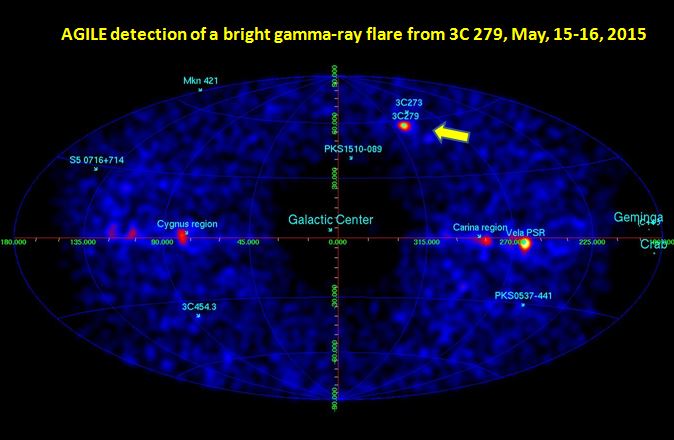
For further information see MEDIA INAF, Atel#7631 and Atel#7639.
Eighth AGILE Birthday
Today, April 23, 2015, it is 8 years since AGILE was launched from the Indian base of Sriharikota on April 23, 2007.
For the video of the event organized at the ASI Headquarters,
please click here
A recent image of the Crab Nebula
AGILE's 40.000 orbits
On January 19, 2015 AGILE reached an important goal, it orbited the Earth 40.000 times since it was launched from the Sriharikota Indian base on April 23, 2007.
A new gamma-ray transient detected by AGILE
in the Galactic Plane
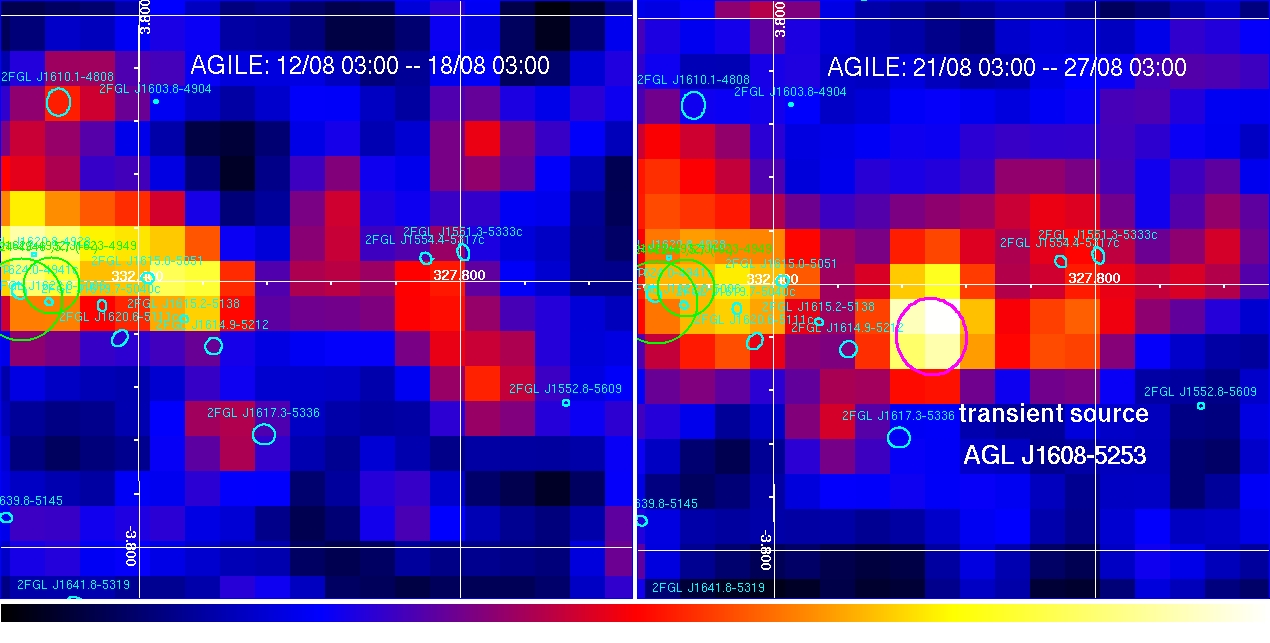
For further information see Atel#6427.
A new gamma-ray flare of the black hole Crazy Diamond 3C 454.3
Press release available at
INAF,
ASI, and
INFN
websites.
AGILE and plasma physics studies
Le Scienze, April 3, 2014. GRB131108A:
A GAMMA-RAY FLASH FROM TEN BILLION YEARS AGO
(detected by AGILE on November 8, 2013)
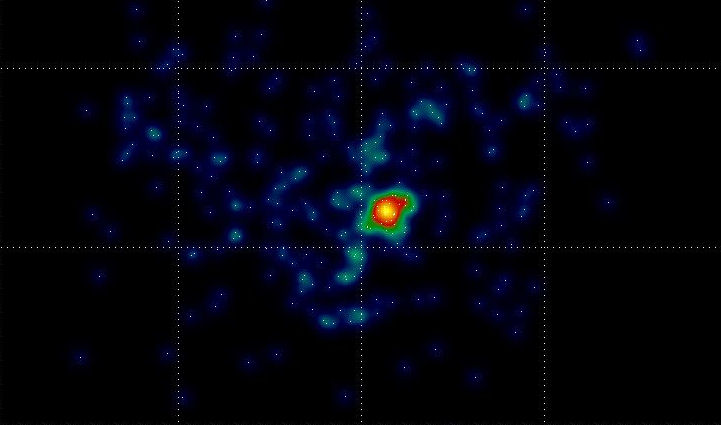
See also AGILE Science App, ASDC News and Media INAF
Press conference on terrestrial gamma-ray flashes at the European Geosciences Union General Assembly 2013
On April 10, 2013 Marco Tavani took part in a press conference at the European Geosciences Union General Assembly 2013 in Wien. The title of the conference was "Thunderstorms and terrestrial gamma-ray flashes". The other participants were Oscar van der Velde, researcher at the Technical University of Catalonia, and Joseph Dwyer, Professor at the Department of physics and Space Science of Florida Institute of Technology.
SuperAGILE detects a Gamma-Ray Burst associated with a Supernova
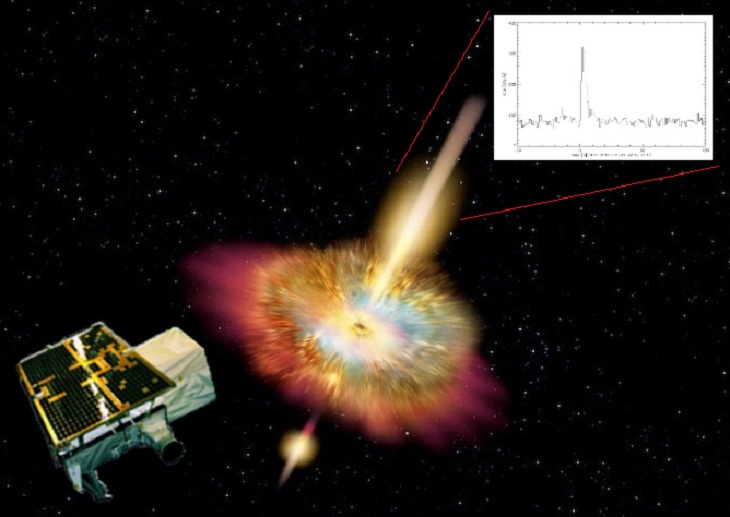
On December 11, 2011 at 22:17:33 UT the SuperAGILE hard X-ray monitor aboard the Italian AGILE satellite localized a Gamma Ray Burst, GRB 111211A (GCN #12666 F. Lazzarotto et al.). The GRB 111211A is the first event detected by SuperAGILE associated with a Supernova (GCN #12802 A. de Ugarte Postigo et al.).While an average number of about 200 - 300 GRBs are localised each year in the X-ray band, less than twenty firm associations with Supernovae are established up to now. The SuperAGILE GRB 111211A is a rare occurrence of a burst which appears to be accompanied by a Supernova explosion, and gives the opportunity to further investigate the GRB-Supernova connection.
See also
INAF news,
ASDC news
AGILE resolves the mystery of the origin of cosmic rays
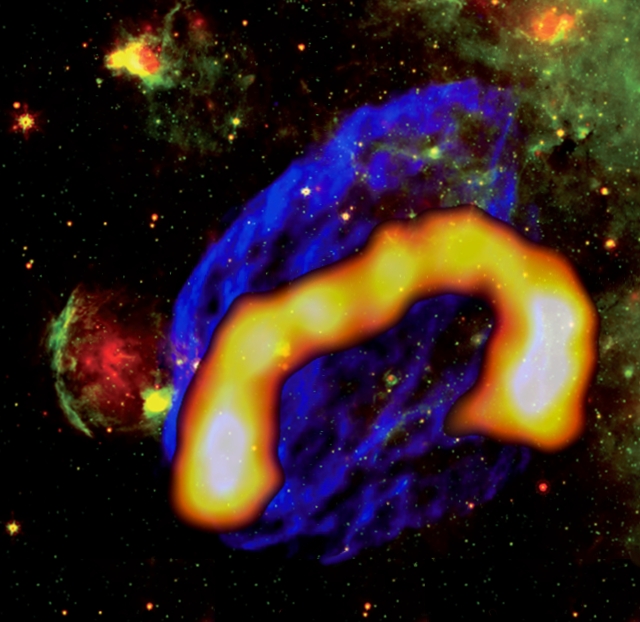
| The AGILE discovery in the Media |
AGILE has discovered a pattern of gamma-ray emission from the Supernova Remnant W44 that can be unambiguosly attributed to accelerate protons smashing against surrounding gas. For many decades, a direct identification of sites in our galaxy where proton acceleration takes place has been elusive. The AGILE data resolves the problem of clearly identifying a source of energetic cosmic rays in our galaxy. The AGILE team reported these findings in the paper by Giuliani et al., ApJL, 742, L30, 2011.
See also
INAF news,
ASI news,
Italian Press Release,
English Press Release
AGILE Cycle-3 Public Data now available
The proprietary period for the AGILE Cycle-3 Observation Blocks (OB) from OB 8600 to OB 10400 has currently expired. The data are public and available from the ASDC Multimission Archive (MMIA) webpage for the AGILE Mission.
New Crab Nebula super-flare on April 16, 2011
A very strong gamma-ray flare was detected by AGILE on April 16, 2011 from the Crab Nebula.
The flux above 100 MeV reached the unprecedented value of
F = (2000 +/- 370) 10^{-8} ph/cm^2/sec.
The Crab was then twice as bright as the Vela Pulsar!
See ATel # 3286
AGILE's 20.000 orbits
On March 10, 2011 AGILE reached an important goal, it orbited the Earth 20.000 times since it was launched from the Sriharikota Indian base on April 23, 2007.
See
ASI News
Media INAF
AGILE discovery that the Crab Nebula is variable

| "Agile 'prende' il Granchio" |
The Crab Nebula is certainly one of the most famous astronomical objects. It is at the center of a bright supernova that exploded in 1054 and was recorded by Chinese astronomers. It encloses now at its very center one of the most powerful pulsars. The Crab has been considered for decades as one of the strongest persistent X-ray and gamma-ray source in the sky and was then used as a standard calibration source in astrophysics. Therefore, when between Sept. 19 and Sept.21, 2010 the AGILE team detected a strongly enhanced gamma-ray emission from the Crab Nebula region (ATel # 2855) it provoked a sort of shock in the community. Following the AGILE discovery and the confirmation by Fermi/LAT on the following day (Atel #2861), many telescopes (Swift, INTEGRAL, Hubble, Chandra) have then pointed and are still pointing at the Crab, gathering precious information for precisely identifying the phenomenon.
See also
INAF news,
ASI news,
ASDC news
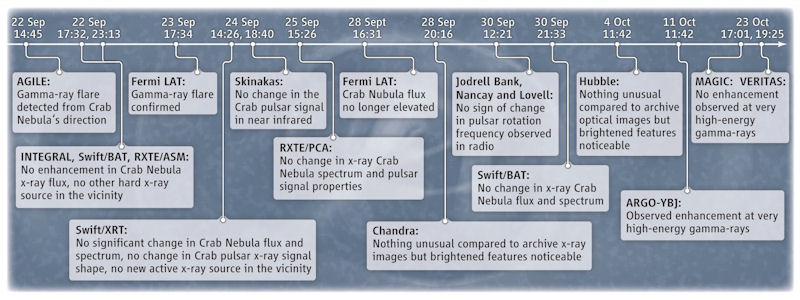
Timetable of the Astronomer’s Telegram releases on the Crab Nebula flare in universal time, within 1 month after discovery on 22 September 2010. Corresponding telegram IDs are: 2855, 2856, 2858, 2861, 2866, 2867, 2868, 2872, 2879, 2882, 2889, 2893, 2903, 2921, 2967, 2968.
Agile article on the Crab Nebula
reporting the surprising gamma-ray flares,
published on Jan. 6, 2011 on Science Express
| "Discovery of Powerful Gamma-Ray Flares from the Crab Nebula" |
| The AGILE discovery in the Media |
See also the official ASI-INAF-INFN press release
Italian version
English version
Ron Cowen reports on ScienceNews about the variability
of the Crab Nebula at the 2010 Texas Symposium, in Heidelberg
| "Crab Nebula’s Violent Outbursts Shock Astronomers" |
The Newton magazine reports about the discovery by AGILE
of the variability of the Crab Nebula
| "Occhio indiscreto" |
AGILE discovery of surprising gamma-ray emission up to 100 MeV from Terrestrial Gamma-Ray Flashes (TGFs)

AGILE latest article on Terrestrial Gamma-Ray Flashes (TGFs)
reporting the surprising discovery of gamma-ray radiation
up to 100 MeV, published on Jan. 3, 2011 by Phys. Rev. Letters
| "Terrestrial Gamma-Ray Flashes as Powerful Particle Accelerators" |
Commentary by J. Dwyer on Physics (Jan. 3, 2011)
See
Chance of thunder and gamma-ray flashes
AGILE detection in November 2010 of the
extraordinary gamma-ray flare from the massive
black hole 3C 454.3
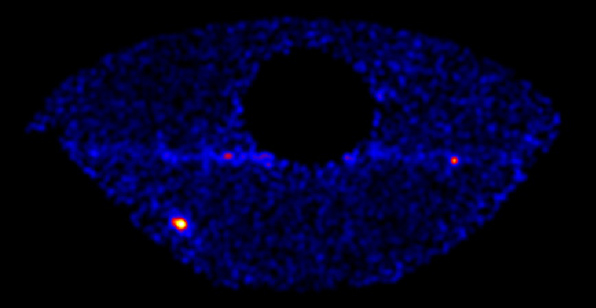
| "Crazy Diamond" fa record con AGILE |
Starting on Nov. 17, 2010 (ATel # 3034) the AGILE satellite detected another extraordinary gamma-ray flare from the blazar 3C 454.3 that we are calling "Crazy Diamond" for the unpredictable variability of its emission. This gamma-ray flare is the most intense and prolonged one (ATel # 3043) ever detected, and transformed 3C 454.3 into the brightest gamma-ray source in the sky.
See also
INAF news,
ASI news
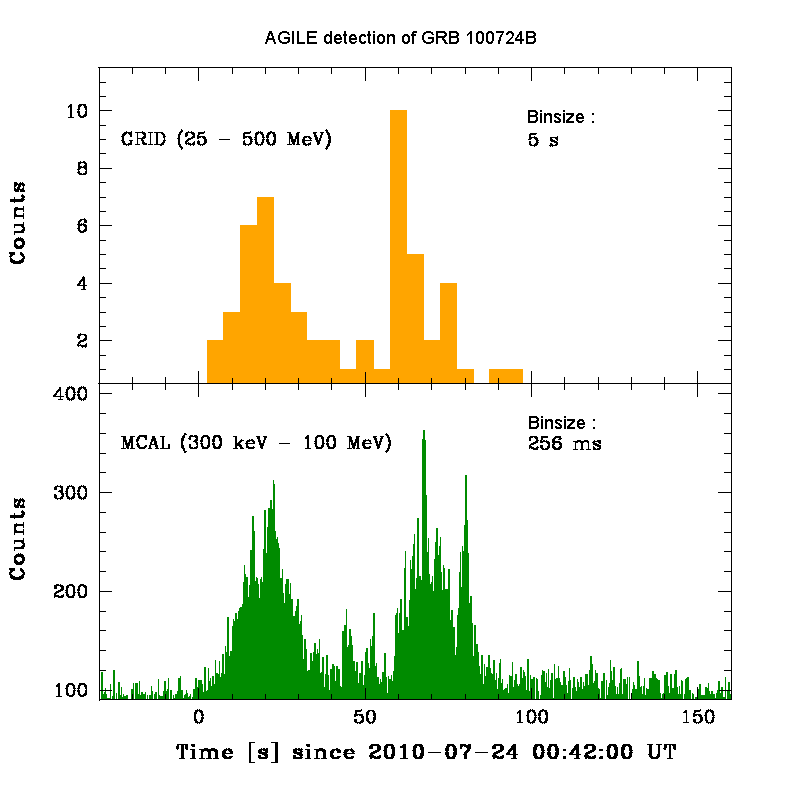
July 26, 2010: The Gamma-Ray Imaging Detector (GRID) on board AGILE detected the long bright GRB 100724B (Bhat, GCN 10977; Tanaka et al., GCN 10978;
Golenetskii et al., GCN 10981, Marisaldi et al., GCN 10994) in the energy range 25 - 500 MeV with a statistical significance larger than 9 sigma.
The gamma-ray emission observed by the AGILE-GRID instrument lasted about 100 seconds, and two peaks are evident in the lightcurve consistent with the behaviour reported by Fermi LAT
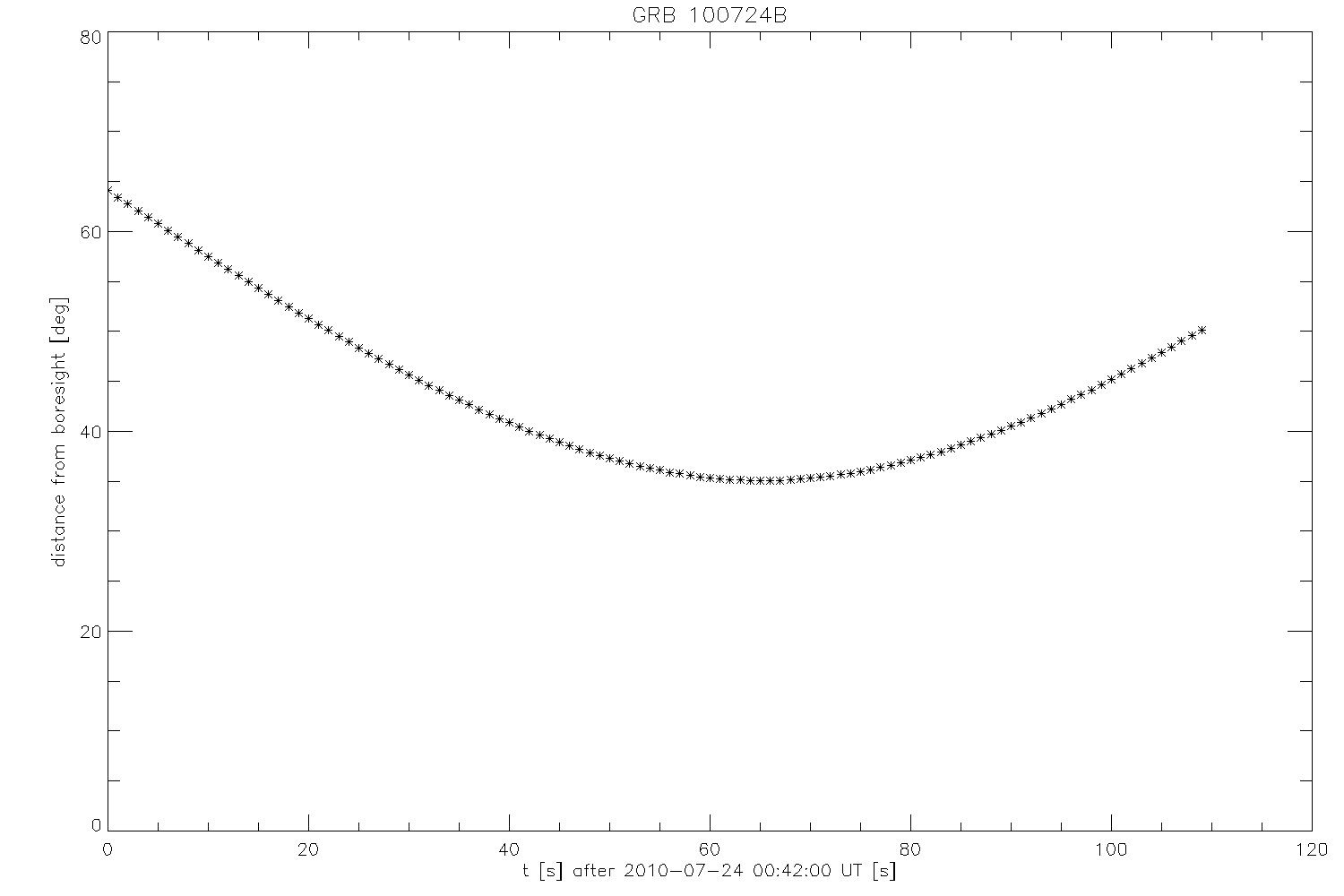
July 26, 2010: A plot showing the distance between the position of GRB 100724B and the AGILE boresight as a function of time.
GRB 100724B turns out to be the brightest GRB detected by AGILE above 100 MeV during its operations in space.
The AGILE satellite detects
"super-energetic TGFs"
The AGILE satellite detects "super-energetic TGFs" that could affect air travel
"Terrestrial Gamma-Ray Flashes" (TGF) are phenomena of terrestrial
(atmospheric) origin only lasting a few milliseconds that are likely associated to very intense tropical thunderstorms. The AGILE satellites detected several of these events since its first months of operations.
The AGILE equatorial orbit, together with its advanced payload capabilities, allowed the discovery of TGFs with gamma-ray energy reaching up to 50 MeV.
Such highly energetic radiation must be produced in atmospheric conditions requiring potential differences of 100 Mega Volts or more, hundreds of times larger than that required to produce the usual terrestrial lightning.
As announced in a joint press release that can be found on the ASI and INAF websites, the AGILE Team and ASI are collaborating with ENAC (Ente Nazionale per l'Aviazione Civile) to understand the possible hazards to air traffic that these very energetic atmospheric events might cause.
THE AGILE paper "Detection of Terrestrial Gamma-Ray Flashes up to 40 MeV by the AGILE satellite" by M. Marisaldi et al. (2009), previously announced on this website on October 29th 2009, is now being published in the Journal of Geophysical research and it is accessible on-line at:
http://www.asdc.asi.it/news/Marisaldi2009_AGILE-TGF.pdf
AGILE DETECTS A GIANT GAMMA-RAY
FLARE FROM THE BLACK HOLE
GALAXY 3C 454.3
("Crazy Diamond")
(December 2-8, 2009)
The strongest ever gamma-ray source in the sky !
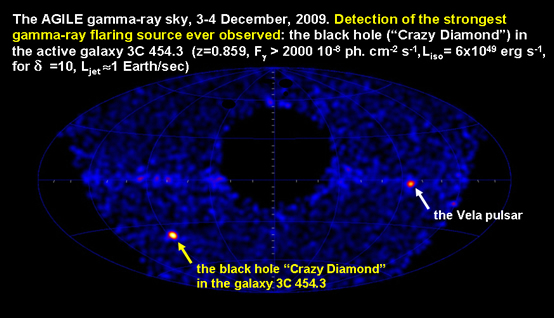
AGILE first detection of gamma-rays above 100 MeV
from the microquasar Cygnus X-3
The paper "Extreme particle acceleration in the microquasar Cygnus X-3",
Tavani et al., Nature, vol. 462, 620-623 (3 December 2009)
Click here
(see also arXiv:0910.5344), reports the AGILE detection of gamma-ray flaring
emission from the microquasar Cygnus X-3, which tends to occur before the onset
of powerful relativistic radio jets.
Press Release
Click here
English Version
Click here

On November 4, 2009 at 12:25:54 the AGILE scientific operations were reconfigured. The satellite will be operating in a "spinning mode", i.e., with the instrument axis sweeping the accessible sky with an angular speed of 1 degree/sec. The instrument and all detectors are operating nominally.
The figure above (in Galactic coordinates) shows a typical 100-orbit gamma-ray intensity map above 100 MeV in the AGILE spinning configuration.



